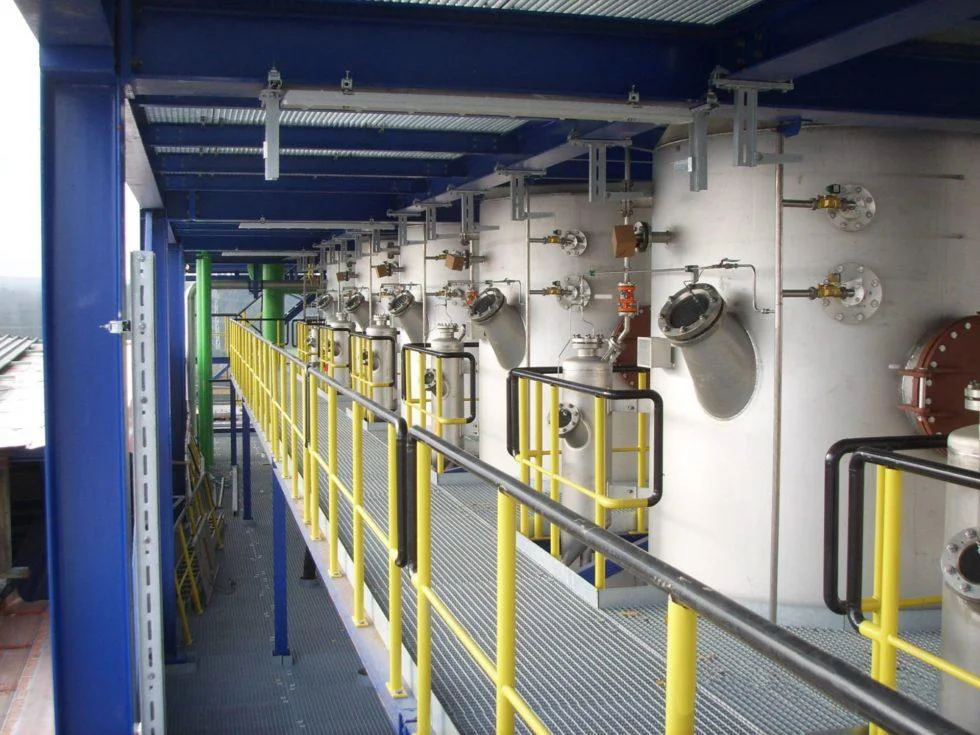Fluidized Bed Crystallization For Water Treatment

Fluidized Bed Crystallization for Water Treatment: A Comprehensive Overview
Water treatment is a critical component in ensuring the sustainability and safety of potable water supplies, industrial processes, and environmental conservation. Among the myriad of techniques developed, fluidized bed crystallization (FBC) stands out for its efficiency and effectiveness in addressing various contaminants, particularly those contributing to scaling and hardness. This article delves into the intricacies of FBC, exploring its principles, applications, benefits, challenges, and future prospects in the realm of water treatment.
Introduction to Fluidized Bed Crystallization
Fluidized bed crystallization is a sophisticated and efficient process used primarily for the removal of dissolved substances from water, leading to the formation of solid crystal particles. The technology leverages the advantages of fluidized beds, where solid particles are suspended and agitated by upward-flowing fluid, typically water.
Crystallization, in the simplest terms, involves the transition of a solute from the dissolved state to a solid crystalline form. In an FBC system, this transition occurs on the surfaces of small seed crystals, which are maintained in a fluidized state.
Principles of Fluidized Bed Crystallization
At the core of FBC lies the principle of fluidization and the nucleation and growth of crystals. Here’s a detailed breakdown:
-
- Fluidization: In an FBC reactor, fluidization is achieved by flowing water upwards at a velocity that supports the suspension of small solid particles, creating a dynamic “bed.” This bed consists of seed crystals or other particulate matter, which act as nucleation sites for crystallization.
- Fluidization: In an FBC reactor, fluidization is achieved by flowing water upwards at a velocity that supports the suspension of small solid particles, creating a dynamic “bed.” This bed consists of seed crystals or other particulate matter, which act as nucleation sites for crystallization.
-
- Nucleation and Growth: As supersaturated water (i.e., water containing more dissolved substance than it can normally hold at a given temperature and pressure) passes through the fluidized bed, dissolved substances begin to precipitate out of the solution and adhere to the seed crystals. This process reduces the concentration of dissolved substances in the water, thereby treating it.
- Nucleation and Growth: As supersaturated water (i.e., water containing more dissolved substance than it can normally hold at a given temperature and pressure) passes through the fluidized bed, dissolved substances begin to precipitate out of the solution and adhere to the seed crystals. This process reduces the concentration of dissolved substances in the water, thereby treating it.
-
- Control of Crystallization: Efficient crystallization requires precise control of several variables, including supersaturation levels, temperature, flow rates, and the introduction of additives that may influence crystallization kinetics.
Applications of Fluidized Bed Crystallization
1. Desalination and Scale Prevention
One of the most prevalent applications of FBC is in the field of desalination and scale prevention. In membrane desalination processes, such as reverse osmosis, scale formation on the membrane surface can significantly hamper efficiency and lifespan. Fluidized bed crystallizers can be used to precipitate out scale-forming minerals like calcium and magnesium before they reach the membranes, thus minimizing scaling and prolonging membrane life.
2. Water Softening
Water hardness, caused primarily by dissolved calcium and magnesium ions, poses various challenges, including scaling in pipes and inefficiency in soap usage. FBC units can effectively remove these ions through the crystallization process, thereby softening the water and mitigating the associated problems.
3. Heavy Metal Removal
FBC technology is also employed in the removal of heavy metals such as lead, copper, and zinc from industrial wastewater. These metals can be harmful to both human health and the environment if not adequately treated. By creating conditions conducive to the precipitation of these metals as crystalline solids, FBC systems can efficiently capture and remove them from the wastewater.
4. Nutrient Recovery
In wastewater treatment plants, the recovery of nutrients like phosphates and nitrates is increasingly gaining attention due to its environmental and economic benefits. Fluidized bed crystallization can facilitate the recovery of these nutrients in the form of valuable by-products like struvite, which can then be used as fertilizers.
5. Industrial Process Water Treatment
Many industrial processes, especially in sectors like petrochemicals, textiles, and food processing, require high-quality water. FBC can be integrated into these processes to maintain water quality, reduce scaling and fouling, and ensure the efficient operation of heat exchangers, boilers, and cooling towers.
Benefits of Fluidized Bed Crystallization
1. High Efficiency
One of the most remarkable benefits of FBC is its high efficiency in removing dissolved substances. By utilizing fluidized seed crystals, FBC can achieve rapid nucleation and growth of crystalline solids, leading to efficient contaminant removal.
2. Scalability
FBC systems are highly scalable, making them suitable for various applications ranging from small-scale industrial setups to large municipal water treatment plants. This flexibility enables customization according to specific treatment needs and operational constraints.
3. Cost-Effectiveness
Compared to other treatment technologies, FBC can be more cost-effective due to its lower energy consumption and reduced chemical usage. Furthermore, the recovery of valuable by-products, such as struvite, can offset operational costs, making it an economically viable solution.
4. Environmentally Friendly
FBC technology promotes sustainability by minimizing waste generation and enabling the recovery of valuable resources from wastewater. Additionally, the reduction in chemical usage and energy consumption contributes to a lower environmental footprint.
5. Operational Stability and Robustness
FBC systems are known for their operational stability and robustness, even in the face of varying water quality and flow rates. This reliability ensures consistent treatment performance and minimizes downtime, which is crucial for industrial and municipal applications.
Challenges and Solutions in Fluidized Bed Crystallization
Despite its numerous advantages, FBC also presents certain challenges that need to be addressed for optimal performance:
1. Optimization of Operating Conditions
Achieving precise control over operating conditions, such as supersaturation levels, temperature, and flow rates, is critical for efficient crystallization. Inadequate control can lead to issues like incomplete crystallization or the formation of unwanted amorphous solids. Advanced sensors and control systems, coupled with real-time monitoring, can help mitigate these challenges.
2. Fouling and Clogging
While FBC systems are designed to handle particulate matter, fouling and clogging of the fluidized bed are potential issues that can reduce efficiency. Regular maintenance, appropriate pretreatment of feed water, and the use of anti-fouling agents can help minimize these problems.
3. Design and Material Considerations
The design of FBC reactors, including parameters such as bed height, particle size distribution, and reactor geometry, plays a crucial role in performance. Additionally, selecting materials that are resistant to corrosion and abrasion is essential for ensuring the longevity of the system.
4. Handling of By-Products
The crystals formed in FBC systems need to be managed properly to avoid secondary pollution. Efficient separation and disposal or reuse of these by-products are necessary to ensure environmental compliance and economic viability.
5. Energy Requirements
While FBC is generally energy-efficient, the process still requires energy input for pumping and maintaining fluidization. Exploring renewable energy sources and optimizing system design can help reduce the overall energy footprint.
Case Studies and Success Stories
Several real-world applications of FBC technology highlight its effectiveness and versatility:
1. Municipal Water Treatment in the Netherlands
In the Netherlands, a municipal water treatment plant integrated FBC technology to address issues of water hardness and scaling. The system achieved significant reductions in calcium and magnesium concentrations, leading to improved water quality and reduced maintenance costs for infrastructure.
2. Industrial Effluent Treatment in India
An industrial facility in India dealing with textile wastewater successfully implemented FBC for heavy metal removal. The system not only met stringent discharge standards but also allowed for the recovery of valuable metals, contributing to the facility’s economic sustainability.
3. Phosphate Recovery in the United States
A wastewater treatment plant in the United States employed FBC for phosphate recovery from municipal wastewater. The recovered struvite was sold as fertilizer, providing an additional revenue stream for the plant while addressing nutrient pollution concerns.
Future Prospects of Fluidized Bed Crystallization
The future of FBC in water treatment looks promising, with several ongoing research and development efforts aimed at enhancing its capabilities:
1. Advanced Materials and Coatings
The development of advanced materials and coatings for FBC reactors can improve their resistance to fouling and corrosion, extending their lifespan and reducing maintenance requirements.
2. Integration with Other Treatment Technologies
Integrating FBC with other water treatment technologies, such as membrane processes and biological treatments, can create hybrid systems that leverage the strengths of different methods for comprehensive water treatment solutions.
3. Smart Control Systems
The advent of smart sensors and control systems can enable real-time monitoring and automatic adjustment of operating conditions, ensuring optimal performance and minimizing human intervention.
4. Resource Recovery and Circular Economy
FBC’s potential for resource recovery aligns well with the principles of the circular economy. Continued research into the recovery and reuse of by-products, such as valuable metals and nutrients, can enhance the sustainability and economic viability of FBC systems.
5. Tailored Solutions for Emerging Contaminants
Emerging contaminants, such as pharmaceuticals and personal care products, present new challenges for water treatment. Research into the application of FBC for the removal of these contaminants can expand its scope and relevance in modern water treatment.
Conclusion
Fluidized bed crystallization represents a sophisticated and highly effective technology in the field of water treatment. Its ability to efficiently remove dissolved substances, scale-forming minerals, heavy metals, and nutrients makes it a versatile and valuable tool for various applications. As advancements in materials, control systems, and integration with other technologies continue to evolve, FBC is poised to play a crucial role in addressing the growing challenges of water quality and sustainability.
By understanding and addressing the challenges associated with FBC, such as optimization of operating conditions and fouling, and embracing the opportunities for innovation, we can harness the full potential of this technology to secure clean and safe water for future generations.


